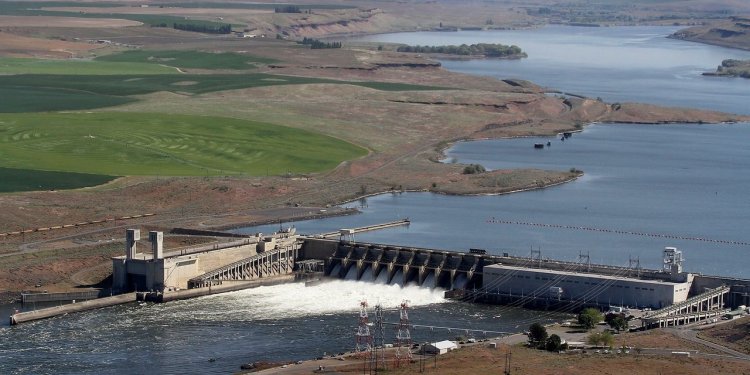Biden’s Fishy Plan to Breach the Snake River Dams
By Faith Bottum June 16, 2023 1:39 pm ET The Ice Harbor Dam on the Snake River near Pasco, Wash. 2013. Photo: Bob Brawdy/Associated Press The Biden administration is committed to destroying four hydroelectric dams on the Snake River in southeastern Washington state. Given the energy crisis in America—with two-thirds of the U.S. risking electricity outages this summer, including nearly everyone living west of the Mississippi, according to a recent warning from the North American Reliability Corp.—it’s a strange time to remove more than 3,000 megawatts of hourly capacity from the Western Interconnection electrical grid. Still, Mr. Biden announced on March 21 that he is determined to bring “healthy and abundant salmon runs back to the Colorado River system.” He meant the Columbia River, but that error was the least of the problems with his

By
Faith Bottum

The Ice Harbor Dam on the Snake River near Pasco, Wash. 2013.
Photo: Bob Brawdy/Associated Press
The Biden administration is committed to destroying four hydroelectric dams on the Snake River in southeastern Washington state. Given the energy crisis in America—with two-thirds of the U.S. risking electricity outages this summer, including nearly everyone living west of the Mississippi, according to a recent warning from the North American Reliability Corp.—it’s a strange time to remove more than 3,000 megawatts of hourly capacity from the Western Interconnection electrical grid. Still, Mr. Biden announced on March 21 that he is determined to bring “healthy and abundant salmon runs back to the Colorado River system.” He meant the Columbia River, but that error was the least of the problems with his announcement.
Environmentalists concerned about salmon spawning have wanted to undam the Snake River for decades. They’ve especially targeted four dams on the lower part of the Snake, before it joins the Columbia: Ice Harbor, Lower Monumental, Little Goose and Lower Granite. Hydroelectric generators at these dams produce enough electricity to power 800,000 homes. It would require roughly three million solar panels occupying well over 6,000 acres to replace the dam’s generation capacity.
In the 1950s, almost 130,000 summer chinook salmon, sockeye salmon and steelheads swam up the Columbia to the Snake in the spring to spawn. By 1992 that number had dropped to just above 10,000. In 2000 the National Oceanic and Atmospheric Administration issued an opinion saying that removing the four dams would bring the salmon back.
In the years since, however, the salmon population has rebounded thanks to improved fish ladders, which allow the fish passage around the dams. This is why NOAA said in 2008, and again in 2014, that it is no longer necessary to breach the Snake River dams. A 2020 report from the Energy Department and the Bonneville Power Administration (the federal agency that manages the electricity from dams on the Columbia River system) concluded that rebuilding salmon stocks didn’t require sacrificing electrical power.
But when the Biden administration took over, NOAA reversed course. In September 2022 it produced a new report claiming that “the science robustly supports riverscape-scale process-based stream habitat restoration, dam removal (breaching), and ecosystem-based management” on the Snake River. The report’s claim of robust scientific support sits awkwardly alongside the authors’ admission that they can provide no “precise measures or quantitative estimates of the magnitude of biological benefit” from removing the dams. They also confess that they have no evidence or authority to “supersede or modify existing analyses.”
In fact, the goals of the report are political, not scientific. Radical environmentalists allied to the Democratic Party are forthright about their desires to reduce the amount of electricity Americans consume. “Democrats want less American energy, less production, and less reliability,” Senate Republican Leader Mitch McConnell (R., Ky.) complained this spring. In a 2022 paper, Stanford University professor of earth system science Robert Jackson argued that Americans should be content to live on a quarter of the energy they do now. Living on less, Mr. Jackson told NPR, would make Americans “healthier and happier” while contributing to “a more equitable world.”
Often portrayed by environmentalists as a uniquely fragile population, the Snake River salmon “are unexceptional,” according to a 2020 study by Kintama Research Services, a Canadian consultancy. In fact, Snake River salmon are hardy during migration. They do as well or better than salmon on undammed rivers in the American West.
What’s more, the environmental effect of the $10 billion to $27 billion dam-removal plan is likely to be terrible. The lost electricity will be replaced with unreliable solar and wind that require backing by new natural-gas plants. Meanwhile Jeff Van Pevenage, president of Columbia Grain International, told the Journal that the Columbia River system “is the top wheat export gateway in the nation and the third-largest grain export corridor in the world,” carrying more than 80 million bushels annually. The removal of the dam’s ship passages, which make the river navigable, will force wheat onto roads and railways. According to a 2020 study by FCS Group, a financial-consulting firm, this will translate into at least 201 additional freight-train loads and more than 23 million miles of new trucking annually—at a considerable carbon-emission cost.
There are reasons to breach dams when backed by consistent science. The breaking of Washington’s Elwha dam in 2012 is a good example: a 90-year-old dam on Washington’s Olympic peninsula that provided little power and halted all salmon runs. But the science on the Snake River dams is unconvincing.
With Republicans in control of the House, the project to breach the Snake River dams seems to be stalling. On May 1, Rep. Cliff Bentz (R., Ore.), chairman of the House Subcommittee on Water, Wildlife and Fisheries, and Rep. Paul Gosar (R., Ariz.) sent a letter to NOAA demanding an explanation for its turn against the dams. Funding for the dam breaching would have to come from Congress and the GOP is starting to wake up to what a disaster that would be. But Democrats are sure to try again when the political stars align.
We need to breach the lower dams, Mr. Biden said, to protect “the livelihoods of people who depend on them, like the family farms, outdoor recreation businesses and rural communities.” Those are precisely the people who will suffer the most if the dams are removed. The loss of reliable hydropower would cause blackouts, and the addition of new trucking and train infrastructure would cause pollution in the communities of southeastern Washington.
Ms. Bottum is an assistant editorial features editor at the Journal.
What's Your Reaction?

















